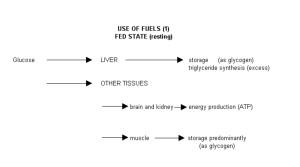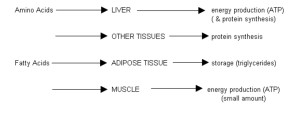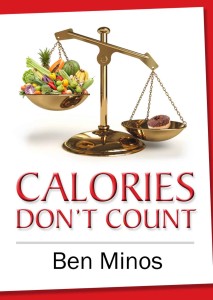TCC The Science of Fat Loss Series Part 4 – The Fed State
You’d think by now scientists would have most things figured out. But you’d be wrong.
A lot of nutritional research has only really happened in recent times. Prior to this, everyone just accepted “conventional wisdom” when it came to all things diet. Little gems such as Fat Is Bad, and Cholesterol Is Bad – amongst others – weren’t based off any in depth controlled research. At best they were made off skewed correlational data.
This also means a lot of assumptions were also made about fat loss. And a lot of generalisations about what happens in the body.
Keep that in mind when reading the following section.
Even though it is one of the most straight forward parts of our discussion, it is a critical transition from us from understanding what is happening at the cellular level in fat loss to the more important macroscopic level that we have control over.
In other words, how the hell do these cellular states get influenced by what we do?
We have looked in some detail as to how your fat cells lose fat and how your fat cells gain fat. What we really need to start asking now is WHAT conditions these states occur in? WHEN do each of these states occur? And HOW best can we go about manipulating it to our advantage?
When scientists talk about different “states” the body can be in, they will generally refer to the Fed State and the Fasting State. The Fed State is obviously what is happening in the body straight after eating a meal. The Fasting State is when all this has settled down and you are in between meals. Bear in mind, when scientists talk about the Fed State, they are always generalising a meal that contains carbohydrates, proteins and fats in large enough amounts. Text books will rarely, if ever, talk about the different composition of meals and the differences these have on those states. This is where it has only been in modern research that scientists began looking at the different composition of diets on body fat levels i.e. low carb vs high carb, etc.
As mentioned, a “meal” according to the following statements are always comprised of a mixture of protein, carbohydrates and fats in ample amounts. And text books will then look at the different fates of these macronutrients based purely on a timeline related to the meal i.e. After a meal, between meals, overnight, while exercising.
This is a very basic way of looking at what is happening. And when looked at purely from this perspective it is easy to see why scientists usually only get caught up in “calories in calories out.” It completely ignores the “state” your body is in at the time – metabolically and hormonally – and how this can actually affect the fates of the different macronutrients also.
In these discussions, you won’t hear much about the activation of the enzymes that govern fat storage and fat loss. aka HSL and LPL from previous parts. That is because, again, context is everything, and for some reason researchers and scientists are great at looking at pieces of the puzzle in isolation, but tend to miss the “forest from the tress”. That is something we will endeavour to do later ourselves.
However, having a basic understanding the Fed State and Fasting State will form the underlying basis on how we can best create the ultimate fat loss environment. And how to avoid overdoing the fat storage environment.
This week we will look in some detail at the Fed State. Followed next week by the Fasting State.
The Fed State (aka Fat Storage Mode)
After you consume and digest a meal, glucose and amino acids are transported from the intestine in to your blood. The fats you eat don’t go through the same line of processing though, instead they are packed in to special packages called chylomicrons and are actually transported to your blood via the lymphatic system. (Remember from your high school chemistry how fat and water don’t mix very well? Your body needs to coat the fat in special proteins so it can be transported through your blood.)
Glucose and Amino Acids HAVE to go through your liver first. Your liver is your blood filter and one of its primary goals is to maintain your blood glucose levels. Fats bypass this process.
So, now you have a whole bunch of Glucose, Amino Acids and Fats injected in to your system.
In response to an increase in blood sugar, you body will increase levels of Insulin. The fed state is characterised by this release of insulin.
We’ve already learnt that insulin is one of the main regulators of your fat cells but it is also one of the most important regulators of cell metabolism in other parts of the body also. The other regulating hormone in opposition to insulin in cell metabolism, is a hormone called Glucagon.
Now, if you remember correctly, we found out last week that it was actually Adrenalin that was the main opposition hormone to insulin. And yes, this is still true as far as your FAT CELL goes. But, Glucagon has no effect on human fat cells. When it comes to other cells, like your liver, Glucagon is actually the opposing hormone to insulin.
Insulin gets secreted by your pancreas and is stimulated not only by blood glucose but also by your Parasympathetic Nervous System (meaning you don’t always need just an increase in blood glucose to get an insulin response). Insulin starts getting released even as soon as you start eating something sweet. Your body has learned over the years, if you have something that tastes sweet, this usually means it has a crap load of sugar. Your body then prepares itself for this glucose onslaught by releasing a little bit of insulin in preparation. You have probably heard or read in an article about dieting before that your body still releases some insulin even though you might be drinking a no sugar soft drink.
This Parasympathetic Nervous System response is also another reason why even if you try to completely eliminate carbs from your diet, you will never actually eliminate insulin.
In this way though, for the scientific definition, INSULIN SIGNALS THE FED STATE.
The high presence of glucose itself drives an increase in glycogen storage. But it also drives insulins release. Again, another example of where storage of something in the body is not only driven by the amount of substrate available, but also the hormonal environment.
Insulin stimulates the storage of fuels. It tells your body to store carbohydrates in both your muscles and liver. It also stops the liver from making its own glucose. If your liver levels are full, it will actually cause your liver to break down its stored glucose and form fatty acids. It will also drive glucose in to your fat cells to make the glycerol backbone. This is why insulin is called the storage hormone. It tells your body to store EVERYTHING
The Fed State:
The immediate energy requirements are being met by the food you have just eaten.
Carbohydrates are used by almost all tissues preferentially. If the body is at rest and fed, metabolic activity will be directed towards storage.

Amino acids absorbed from the gut will be used largely for protein synthesis with a small amount used directly for ATP synthesis depending on the body’s energy requirements.
Similarly, fatty acids will be stored predominantly with a small amount used for ATP production.
These storage processes are all stimulated by insulin.

If you went by this information, you would think the Fed State is a terrible thing to be in, as it would promote fat storage. But, hey, you still have to eat right?
When you look at things from this perspective, and include the basics of the calorie theory. You could appreciate why researchers restrict themselves to the argument of “it’s all about calories in / calories out”.
Hopefully, you can begin to appreciate the limitations of just looking at things from such a basic perspective though. As you will find out soon, there are so many other factors and so many other hormones that influence the flux of your fat cell beyond just the basic substrate availability and insulin release.
It is, however, important for you at this stage to understand in order to appreciate everything that we will cover later on.
In future posts, we will begin to explore everything that makes up the Ultimate Fat Storage state and what makes up the Ultimate Fat Burning State. What happens during the Fed State will make up part of that discussion, but it won’t be defined completely by it.
Key Points to Remember:
1) The Fed State = storage mode = fat storage mode
2) The Fed State by the scientific version is after a meal and is characterised by insulin release. (Which, by this definition, usually involves more than enough carbs for what your body can deal with at that time.)
Next instalment in the series will explore what happens in between meals and overnight and why the Fasting State is also known as the Fat Loss State.
Coming Up in Part 5 – The Fasted State
 Ben Minos has Bachelor degrees in both Physiotherapy and Exercise Science (Human Movements). He has worked as a Personal Trainer for 20 years and a Physiotherapist for close to 15. Ben has authored a book on nutrition titled
Ben Minos has Bachelor degrees in both Physiotherapy and Exercise Science (Human Movements). He has worked as a Personal Trainer for 20 years and a Physiotherapist for close to 15. Ben has authored a book on nutrition titled